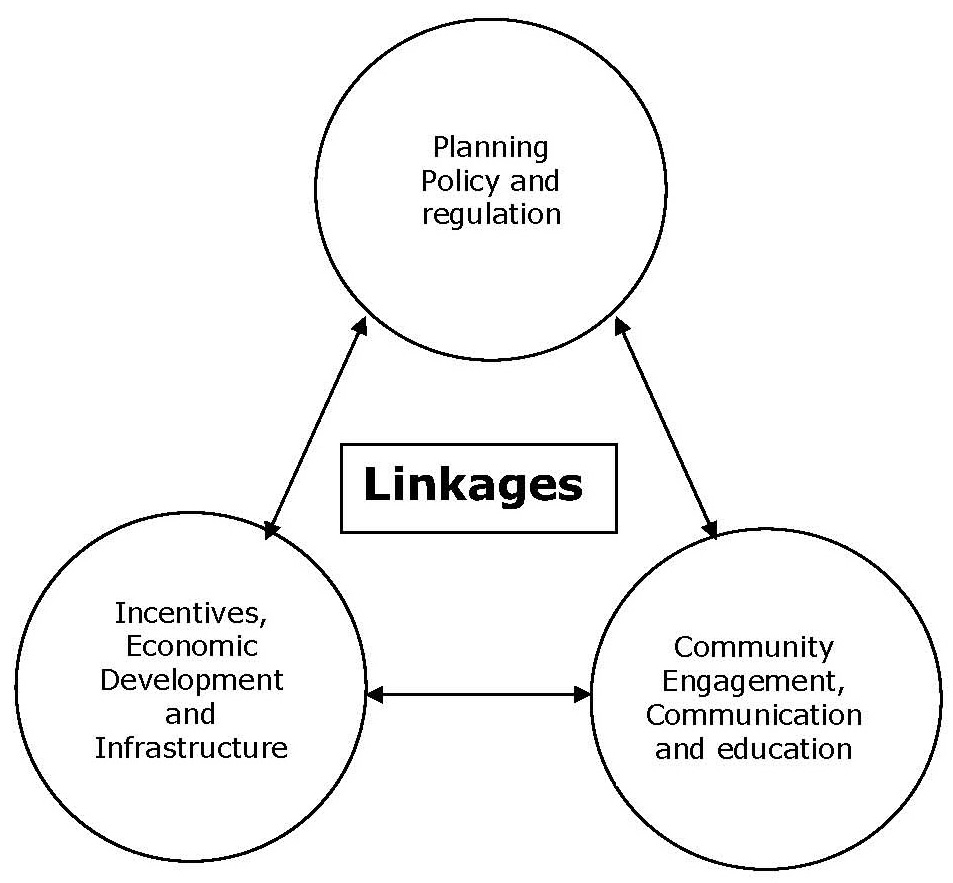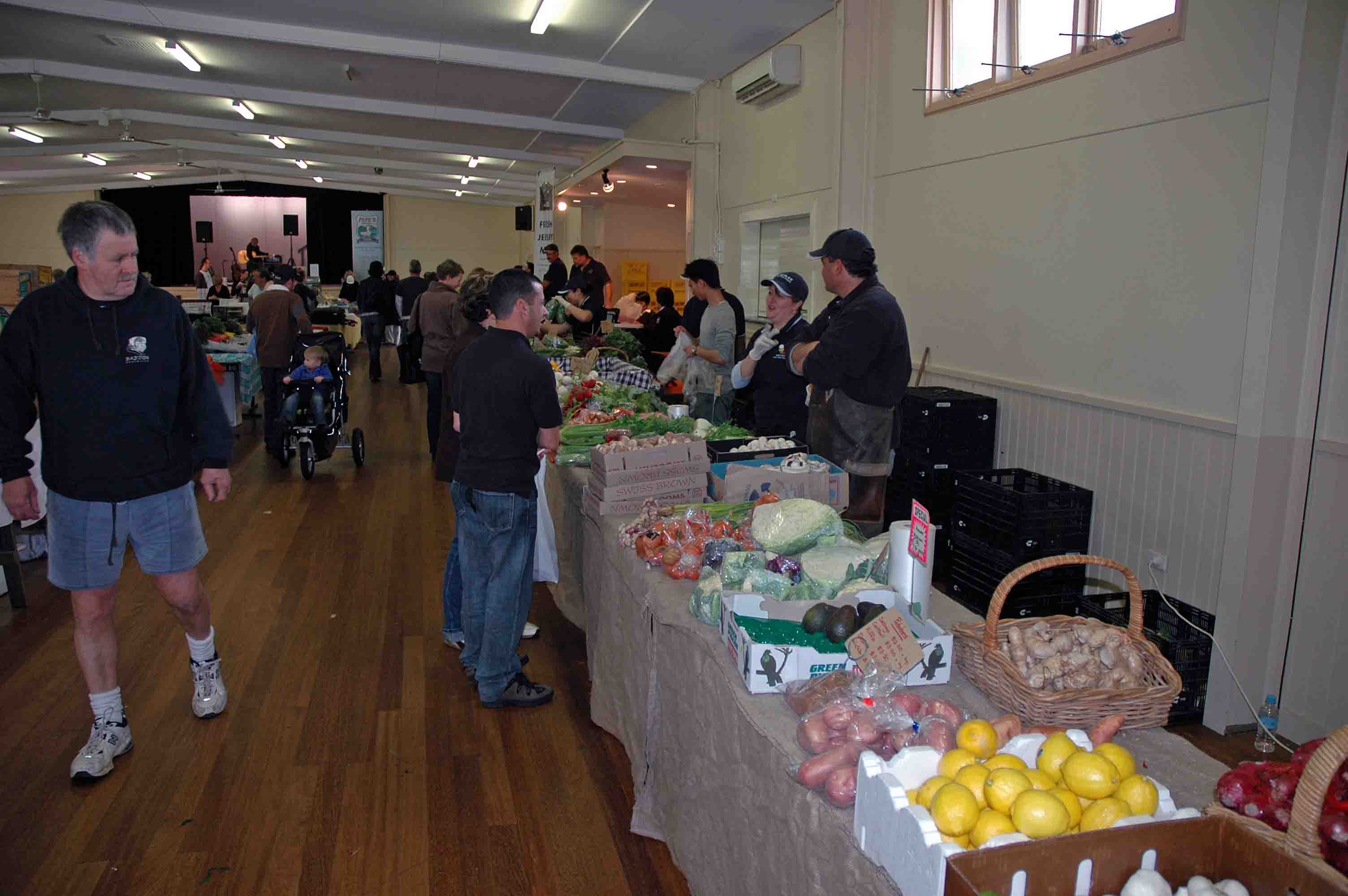

Newsletter
A View From The Edge
Issues in Rural and Metropolitan Fringe Planning
Ian Sinclair,
Principal Consultant, Edge Land Planning
Rural and Environmental Planning Consultants
As published in New Planner, The Magazine of the Planning Profession in NSW
Number 82, March 2010
Please note that this is a longer version than the one printed in New Planner
Planning for Sydney's Food Security - Policy Responses
The policy response to planning for Sydney's food security has basically been done by planning policy and regulation, but overseas research shows that there is a need to balance these mechanisms with incentives, economic development initiatives and farming infrastructure while also encouraging community engagement, communication and education. There is also a need to identify the linkages as can be seen in figure 1.

Planning policy includes the development of appropriate strategies, zoning and land-use regulation. Planning strategies enable planners to gain an overall perspective and define the issues in a particular area and are formulated prior to the introduction of zoning policies
Zoning and land-use regulations involve restrictions on the use of land by statute. Zoning is practised in NSW as the principal method of controlling the development of land and thereby addressing rural land-use conflict and preserving land.
Right to Farm legislation is an attempt to protect farming operations from objections about loss of amenity from rural residential users in the vicinity. It is used in the United States to give farmers the right to continue farming as long as they are carrying out 'good management practices'. As has been pointed out in a review of Right to Farm ordinances in California, however, 'right-to-farm ordinances are a limited answer to the problems of conflict and incompatible land uses at the agricultural-urban edge. The solution also depends on other and more active measures, especially the planning and design of urban development that is sensitive to agricultural operations and appropriate modifications in farm practices at the edge'.
Incentives include density bonuses; purchase of development rights/credits; transfer of development rights/credits; and remission/rebates of council rates.
Density bonuses mean that an application for rural residential use can be varied so that part of the land involved can be retained for farming, while the allowable density for residential use in the remainder of the land that is the subject of the application is raised to compensate. The outcome is that there is a clustering of the subdivision for residential purposes on one part of the property while a larger part is retained for low-intensity agriculture, such as grazing or keeping horses. Density bonuses are not appropriate for intensive forms of agriculture because of the potential for land-use conflict.
Purchase and transfer of development rights/credits exist in the United States. Purchase of development rights or credits can be used where land is declared to be in a preservation zone and kept for agricultural purposes. A farmer can sell the development rights or credits pertaining to the farm to a government or non-government organisation. In return, a covenant is taken out over the land to ensure that the land is used only for agricultural purposes.
Transfer of development rights or credits is another incentive. The development rights or credits to the land can be purchased by developers who wish to gain an increase in the development potential of the land declared to be in a development zone (usually an urban area). Governments or non-government organisations can also establish a bank of such rights or credits, so that buying and selling can take place, as is the case with water entitlements. The process depends on establishing an effective market in such rights. It has been applied to heritage buildings and increase of floorspace (City of Sydney) and biodiversity preservation (NSW BioBanking Scheme).
Council rates are one of the largest single outlays for an agricultural producer, and rate remission can help keep land in farming. Rate charges are based on land value, and can range from $2,000 to $60 000 or more, depending on a farm's size and location. As rural land becomes more desirable for rural residential use, land values increase, with a corresponding impact on rates. The farming community has borne this cost, often without a commensurate increase in the value of production, and this is more problematic where intensive farming - for example, market gardening, flower-growing intensive animals - is already common. This creates a fundamental inequity between urban and rural areas where residents of urban areas adjoining rural land pay much less (in the order of $500 to $800) and have many more services than people living in adjacent rural areas.
Economic development initiatives are also used to ensure that farming can continue, thereby providing for food security. These initiatives include farm gate sales, whereby farmers are permitted to sell produce from their farm. Others include agritourism, farmers' markets, community gardens, local branding and incentives for farmers to deal directly with restaurateurs, which give the restaurateur access to fresh reliable produce and the farmer access to a secure and reliable market.
There is a need to ensure that there is sufficient infrastructure to allow agriculture to continue. This includes water as well as access to produce stores, farm machinery dealership, mechanics, transport (road, rail and air), access to consultants and other professionals as well as a workforce.
There is also a need to engage with the community to make them aware of the importance and benefits of farmland. Connections can be made between urban agriculture and the community, thereby encouraging healthy lifestyles. It is important to communicate with the various stakeholders to ensure that they are all involved and know what is happening in other areas and fields of expertise, thereby creating an environment for collaboration. Education is useful in overcoming misconceptions about the idyllic rural lifestyle sought by those moving to the country from urban areas. The restaurant and catering industry can play an educative role by promoting fresh food from nearby sources. Events can be designed to draw attention to the importance and characteristics of rural production, such as the Hawkesbury Harvest, which runs a number of farmers markets, such as the Castle Hill Growers Market shown in photo 1. They also run a farm gate trail. Initiatives in agritourism, such as the wine and food festivals (Manly) and musical events and concerts in the vineyards in the Hunter Valley and Wingecarribee are also useful in promoting community awareness of local agricultural production.

It needs to be recognised that we cannot grow all foods needed in Sydney but as outlined in the previous article, Sydney has a good climate and market proximity for some foods and we should take advantage of this.
An effective policy response to planning for food security has to include all of these matters. In the Sydney region a number of things can be done. The best land can be identified and zoned and incentives can be applied to the land to ensure that it can be retained in the long term. Also, links can be made between these farms and the local restaurant industry and farmers markets. There could also be a farm gate trail set up to promote this. A locally grown scheme could be set up and be promoted by local cafes and restaurants to promote the local farming. In new residential estates, land could be set aside for community gardens like it is done for parks.
If all of this is done, there should be a future for Sydney's food security. If nothing is done the supply of food will be less secure, which is unsustainable.
Top of page...
launched March, 1999
copyright © 1999 - 2013 Edge Land Planning
All rights reserved.